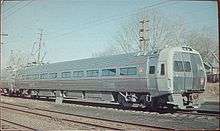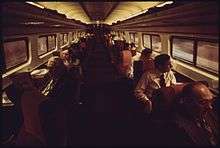Budd Metroliner
| Metroliner | |
|---|---|
|
Penn Central Budd Metroliner No. 880 on the inaugural run of the Metroliner service on January 16, 1969 | |
| Manufacturer | Budd |
| Entered service | 1969 |
| Number built | 61 (31 coaches, 20 snack, and 10 parlor cars) |
| Fleet numbers |
(original) 800-830, 850-869, 880-889 (current) 9632–9651, 9800 |
| Operator(s) |
Penn Central, Amtrak |
| Line(s) served | Keystone Corridor, Northeast Corridor, New Haven – Springfield Line |
| Specifications | |
| Car length | 85 ft 0 in (25.91 m) |
| Width | 10 ft 6 in (3.20 m) |
| Height | 14 ft 10 in (4.52 m) (pantographs locked down) |
| Doors | Two per car |
| Maximum speed |
150 mph (241 km/h) design 125 mph (201 km/h) in service (1968-1978) 90 mph (145 km/h) in service (1978-1980s) 125 mph (201 km/h) in converted cab car configuration |
| Weight | 166,000 lb (75,000 kg) |
| Power output |
1,200 hp (890 kW) (coaches) 1,020 hp (760 kW) (parlor and snack cars) |
| Transmission | Rectified direct current supplied via 4 Ignitron tubes to a phase angle controller to either 4 Westinghouse 1461-A 300 hp DC traction motors (coaches) or 4 General Electric 1254-A1 255 hp DC traction motors (parlor and snack cars). |
| Electric system(s) |
Catenary 11-13.5 kV 25 Hz AC 11-13.5 kV 60 Hz AC 25 kV 60 Hz AC |
| Current collection method | Pantograph |
| UIC classification | Bo′Bo′ |
| Bogies | Outboard bearing, equalized. |
| Braking system(s) | Electro-pneumatic, dynamic |
| Coupling system | Tomlinson (later changed to AAR) |
| Track gauge | 4 ft 8 1⁄2 in (1,435 mm) standard gauge |
The Budd Metroliner car was an electric multiple unit ("EMU") train designed for first-class, high-speed service on the Pennsylvania Railroad's route between New York City and Washington, DC.
Built between 1968 and 1969, they operated in eponymous service on the Penn Central beginning in early 1969 (after the Pennsylvania's merger with the New York Central) and continuing under Amtrak after the latter's 1971 creation. These cars would be an important factor into the creation of the Amfleet cars, also manufactured by Budd. The single-ended units were designed to be arranged in two-car sets which in turn were coupled into four to eight-car trains.
History
The High Speed Ground Transportation Act of 1965 started a U.S. government effort to develop a high speed train for Northeast Corridor service. The U.S. Department of Transportation worked with the Pennsylvania Railroad, Budd Company, General Electric, and Westinghouse to develop an electric multiple unit high speed passenger train, hoping to begin in 1967.[1]

The ancestor of the Metroliner multiple unit railcar was the Budd Pioneer III which had been developed for the Pennsylvania Railroad in 1958 as a new concept in long distance passenger service in the east. The cars used new propulsion technologies and lightweight construction in an effort to improve performance compared with older electric MU technology. After a fleet of 55 improved Pioneer III cars referred to as Silverliners were ordered for commuter trains in the Philadelphia area, the United States Department of Transportation placed a follow up order for 4 Silverliners, specially modified for high speed operation on the PRR's Northeast Corridor. Equipped with several modifications, including a semi-streamlined slab end on the front of the lead car, the experimental train ran a series of test runs, reaching a speed of 156 miles per hour (251 km/h) in 1966.[2]
The Metroliner program was originally a partnership between the Pennsylvania Railroad, U.S. Department of Commerce (prior to the establishment of the Department of Transportation in 1967) and ICC and the first units were delivered in late 1967 with PRR livery. The Penn Central merger in 1968 resulted in the remainder of the cars being delivered with the PC logo, although PRR-specified gray paint with red pinstripes was retained around the windows. In 1968 the prototype Metroliners reached 164 miles per hour (264 km/h) on test runs around Princeton Junction, NJ,[2] but troubles with the ambitious technology prevented the start of service until 1969. Due to the condition of the track and signal system the Federal Railroad Administration only allowed Metroliners 120 miles per hour (190 km/h) between Washington and New York. Still, this was faster than anything else in North America and provided speed, comfort and amenities that could compete with the airlines.
The Amtrak Years

In 1971 the Metroliner cars were transferred from the bankrupt Penn Central to the newly formed National Railroad Passenger Corporation (Amtrak). The cars continued to be unreliable. In 1979 and 1980 Amtrak sent a number of Metroliner cars through a modification program that relocated some of the electrical components from under the floor of the vehicle to a streamlined hump of the roof to alleviate problems with blowing snow getting into the workings. In corridor service the cars typically ran in 6-car sets, although 4-car and 8-car trains were occasionally run. Some cars were repainted in Amtrak's Phase I paint scheme with red, white and blue ends and a small Amtrak logo. Later in 1980 some cars received the Phase II scheme, a red and blue front end with a large Amtrak logo across the full width. Many Metroliners that received this paint scheme did so in conjunction with the roof hump modification. In 1976 Amtrak contemplated ordering an additional 118 Metroliners, dubbed Metroliner II. This projected order was later cut back to 50 cars and finally cancelled altogether.[3]
Around 1980 Amtrak embarked upon another capital program to upgrade the worn out track and purchase new locomotives and rolling stock to finally achieve the performance goals that the Metroliner cars had never been able to reach. The nearly 500 Amfleet I cars which had arrived between 1975 and 1978, which had the same outward appearance of the Metroliners, were to be pulled behind a fleet of 52 new AEM-7 locomotives at 125 miles per hour (201 km/h). As this equipment was delivered the Metroliner MU cars began to be withdrawn as the MUs were increasingly worn and unable to achieve speeds the upgraded track would allow.
In the mid-1980s a number of the Metroliner MU cars were re-branded as Capitoliners to work Amtrak's Harrisburg Line between Philadelphia and the state capitol of Harrisburg, however there were no actual modifications to the equipment. By this point reliability had become such a problem that trains of Metroliners were towed by electric or sometimes diesel locomotives.
Conversion to Control Cars
In the late 1980s Amtrak found itself with a supply of surplus MU cars with problematic propulsion systems, but with sound body and frame. Most Metroliners were stored at Amtrak's Wilmington and Bear, Delaware shop complexes, but a few had their MU components removed and were converted into either cab control cars for push–pull train service or trailer coaches. They initially saw service on regional trains out of Los Angeles and Chicago and Amtrak's Atlantic City Express. They eventually found their way onto Amtrak's Springfield Shuttle, Keystone Service, and the Vermonter. Snack bar unit 863 is now 9800, a business/conference car available for charter and special events.
Preservation
One Metroliner snack bar car (860) has been preserved at the Railroad Museum of Pennsylvania in its original paint scheme and with an original interior. As of 2009 a few former Metroliner cars remain in storage on Amtrak property at the Bear, Delaware, shops. One unit at Bear (9709, ex-809) retains its Phase II appearance with an unmodified front end.
See also
- Metroliner (former service)
Notes
- ↑ Trains Magazine (June 30, 2006). "Metroliner's amazing career - Pivotal moments in the life of America's first high-speed train". www.trains.com. Retrieved January 29, 2016.
- 1 2 Staufer, Alvin F.; Pennypacker, Bert (June 1968). Pennsy Power II: Steam Diesel and Electric Locomotives of the Pennsylvania Railroad (1st ed.). Medina, OH: Alvin F. Staufer. ISBN 978-0944513057. OCLC 8029618.
- ↑ ICC 1978, p. 17
References
- Interstate Commerce Commission (March 15, 1978). Amtrak : Interstate Commerce Commission's report to the President and the Congress, effectiveness of the act, March 15, 1978. United States Government Printing Office. OCLC 4147074.
External links
-
 Media related to Budd Metroliner at Wikimedia Commons
Media related to Budd Metroliner at Wikimedia Commons - Metroliner fleet roster and car renumberings
- Fleet details, specifications, dispositions
.jpg)